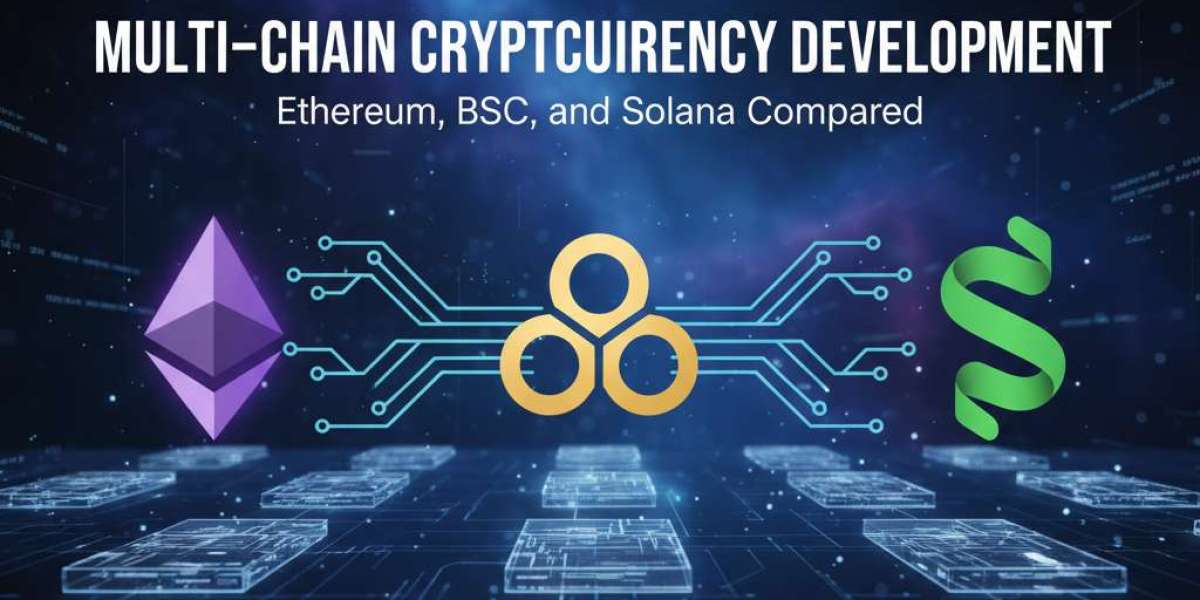Choosing a base chain is no longer a binary decision between “cheap vs. secure.” In 2025, most serious teams think multi-chain from day one—picking a primary home, then extending to the networks where users actually are. This article compares Ethereum, BNB Smart Chain (BSC), and Solana through the lenses that matter to builders: execution model and security, performance and fees, developer experience, ecosystem liquidity, and the practical realities of shipping consumer-grade apps across chains.
1) Architectures and security trade-offs
Ethereum (with rollups). Ethereum’s execution layer is deliberately conservative: it prioritizes decentralization and client diversity, while pushing most user activity to Layer-2 rollups. Since the March 2024 Dencun upgrade (EIP-4844), the protocol supports “blob” data space that rollups use to post transaction data cheaply—preparing the way for full Danksharding. In short: the base chain anchors security; rollups deliver scale.
BNB Smart Chain (BSC). BSC offers EVM compatibility with short block times and a Proof-of-Staked-Authority design centered on a small active validator set (commonly described as ~21 validators). It emphasizes throughput and fast confirmations while accepting a more centralized trust model than Ethereum’s. BSC also extends horizontally with opBNB, an Optimism-stack L2 that inherits BSC security assumptions while providing even lower fees.
Solana. Solana is a high-throughput, monolithic L1: Proof-of-History helps order transactions, and the Sealevel runtime executes transactions in parallel where accounts don’t conflict. Over the past two years the network has invested heavily in fee markets and client upgrades; a new independent validator client (Firedancer) from Jump Crypto has demonstrated extremely high performance in testing, with the aim of improving robustness and throughput as it matures.
Security takeaway. Ethereum’s model minimizes trust in any single sequencer by anchoring to a highly decentralized L1 and evolving toward data-availability sharding. BSC optimizes for speed with fewer validators and complements it with an L2 (opBNB). Solana aims for a one-chain, high-throughput design—reducing cross-domain trust assumptions, but requiring sophisticated client and runtime engineering to handle spikes and congestion.
Multi-chain token development is a smart move for projects aiming to expand liquidity, reach diverse user bases, and enhance interoperability across major blockchain ecosystems. By launching tokens on networks like Ethereum, BSC, and Solana, businesses gain cross-network utility, seamless asset transfers, and greater resilience against single-chain limitations.
2) Fees, throughput, and finality—what users actually feel
Ethereum + rollups. Dencun’s blob space materially dropped L2 data costs; across major rollups, typical swap and transfer fees fell to the cents—or sub-cent—range, and often remain there in normal conditions. Public dashboards like L2Fees show current rates by rollup in real time, while multiple academic and industry analyses documented 10x (or more) drops after March 2024. The result: you can now build consumer experiences on Ethereum’s L2s without pricing out users.
BSC / opBNB. On BSC, gas costs are usually a fraction of comparable Ethereum L1 transactions thanks to the shorter block times and validator design, and opBNB pushes per-tx costs even lower by batching via Optimistic rollups (built on the OP Stack). For EVM apps that crave low fees without leaving the Solidity toolchain, BSC + opBNB is a pragmatic option.
Solana. Base fees are set in lamports per signature and remain tiny—typically fractions of a cent—because the protocol’s design keeps computation and networking efficient at scale. The public docs explain how transaction fees and “compute units” interact, and why localized fee markets were introduced to help during high load. In practice, even with spikes from high-volume trading or mints, most consumer actions stay extremely cheap.
Finality and UX. All three ecosystems offer “practical finality” in seconds for most uses. Rollups add a nuance: optimistic rollups rely on challenge windows for economic finality, though UX-level confirmations are fast; ZK rollups shorten that tail even further. Solana’s finality is fast at the protocol level; BSC confirmations come quickly given its validator design; Ethereum L1 finality is slower but rollups mask it for UX.
3) Developer experience and tooling
EVM world (Ethereum & BSC/opBNB). Solidity/Vyper, Hardhat and Foundry pipelines, extensive audit patterns, and deep standards (ERC-20, ERC-721/1155, ERC-4337 wallets) make EVM development a familiar path. Uniswap’s contracts, for example, are deployed across many EVM L1s and L2s—illustrating how mature tooling enables multi-chain deployments with limited code changes. If you can ship on one EVM, you can typically ship on many.
Solana (Rust + Anchor). Solana’s account model separates program code from state; you’ll manage accounts explicitly, budget compute, and design around parallel execution. The Anchor framework gives a batteries-included developer experience (IDLs, macros, testing), and the official docs and community tutorials are strong—but the learning curve is real for EVM-native teams. The payoff is performance and low fees at L1.
DX takeaway. EVM gives you speed-to-market and a vast library/fork culture; Solana rewards teams willing to think “systems-first” in exchange for high throughput and ultra-low costs.
4) Liquidity, users, and where your app will be discovered
Ethereum remains the center of gravity. By value locked and breadth of protocols, Ethereum still anchors DeFi and NFT infrastructure. As of today, DefiLlama reports Ethereum’s DeFi TVL around the $90B+ mark, plus deep stablecoin liquidity and active DEX volume—now increasingly split between mainnet and L2s like Arbitrum, Optimism, Base, and others.
BSC’s retail-heavy flow. BSC consistently ranks among the most active networks by daily addresses and transactions, with a DeFi TVL in the multi-billion range and heavy DEX activity (e.g., PancakeSwap). It excels for campaigns, games, and mass-market on-chain actions where fees and immediacy matter more than maximal decentralization.
Solana’s scale story. Solana’s resurgence has paired deep DEX/liquidity routing (e.g., Jupiter) with massive on-chain activity: tens of millions of daily transactions and millions of active addresses on busy days, while keeping fees negligible. That combination is attractive for high-frequency trading, consumer apps, and mobile-first experiences.
5) Interoperability and multi-chain patterns
Bridges and messaging are the glue—but also the risk surface. Cross-chain exploits historically drove some of the largest losses in crypto; modern designs have improved, yet the safest path is still to minimize cross-domain state and prefer native deployments with local liquidity where possible. On Ethereum, rollup-to-rollup coordination is evolving through shared standards and the OP Stack “Superchain”; BSC adds opBNB within its own umbrella; Solana relies on battle-tested bridges and growing native liquidity to integrate with EVM ecosystems.
Working playbook (what most teams do in 2025):
Pick a “home base.” Choose Ethereum (often an L2) if you need the deepest security and composability; pick Solana if you need single-chain scale and ultra-low fees; pick BSC if you want low-friction EVM distribution and fast retail discovery.
Deploy natives first; bridge assets later. Keep state local; bridge only what you must.
Abstract chains away. Use routers, aggregators, and intent-based flows so users feel “one app,” not “three blockchains.”
6) Case snapshots
Uniswap (Ethereum-first, multi-chain EVM). Uniswap’s protocol spans Ethereum mainnet and multiple L2s and sidechains, from Arbitrum and Optimism to Base, Polygon, and beyond. The codebase stays EVM-centric, while governance and liquidity strategies adapt per chain. For teams with established Solidity stacks, this is the canonical “start on Ethereum, expand where users are” model.
PancakeSwap (BSC-native, multi-chain EVM). Built originally for BSC’s low fees and fast blocks, PancakeSwap was designed for broad retail participation and later expanded to other EVM chains. If your tokenomics and campaign cadence depend on very low costs and quick feedback loops, this pattern fits.
Jupiter (Solana-native aggregation). On Solana, Jupiter’s router/aggregator has become infrastructure for many apps, offering APIs that let developers embed sophisticated routing without building a DEX from scratch. This is emblematic of Solana’s consolidation around low-latency, high-throughput primitives.
7) Costing and shipping the same app three ways
Imagine a simple on-chain marketplace with swaps, listings, and a light social layer.
Ethereum path. Ship to an L2 like Base or Optimism for low fees, then add Arbitrum/Polygon. Keep core contracts minimal and upgradeable, and rely on standardized libraries. Expect robust audit options and widely available monitoring/MEV-protection tooling. Thanks to blobspace, fees for swaps and transfers are generally a few cents or less in normal conditions.
BSC/opBNB path. Port your Solidity code; leverage BSC for base liquidity and discovery, then extend to opBNB to push fees still lower for social interactions and micro-transactions. This route is ideal if your user acquisition strategy leans on airdrops, quests, or frequent low-value actions.
Solana path. Build programs in Rust with Anchor. You’ll design around accounts, compute budgets, and concurrency; testing is a bit more “systems-engineer-ish,” but the payoff is one chain handling high-frequency usage at sub-cent fees. Apps that require frequent writes (e.g., orderbooks, micro-tips, in-game actions) map well to this model.
8) Reliability notes you should plan around
Every network has stress moments. Solana’s 2024 outage (hours, not days) catalyzed a series of upgrades to scheduling, fee markets, and networking; the forthcoming Firedancer client aims to harden performance further. Ethereum L2s, while cheap, add operational nuance: each rollup has distinct bridges, sequencers, and failure modes that your SREs must understand. BSC’s validator set and governance allow faster incident response, which can be a feature for some businesses and a centralization concern for others. Architect your app so degradations don’t become downtime.
9) Data points to anchor expectations (today)
Ethereum (incl. L2): Dencun (EIP-4844) enabled cheap blob data for rollups; many L2 swaps and transfers price in the cents/sub-cent range (check L2Fees for current conditions). TVL remains the largest by value across chains.
BSC: Multi-billion TVL with heavy daily activity and strong DEX throughput; opBNB provides an L2 route for ultra-low fees within the BNB ecosystem.
Solana: High daily transactions and active addresses; fees remain fractions of a cent; developer docs specify the fee model (lamports per signature) and compute budgeting.
10) Which chain for which job?
High-value DeFi, regulated flows, institutional trust.
Start on an Ethereum L2 for UX; keep a canonical mainnet presence for governance/treasury. The rollup-centric roadmap continues to harden the security-to-scale trade-off while L2 fees stay low.
Mass-market campaigns, games, and consumer social.
BSC for immediate reach and low cost; consider opBNB for the cheapest interactions while keeping Solidity tooling.
Real-time markets, high-frequency interactions, and mobile UX.
Solana for single-chain throughput and micro-pricing at L1; pair with robust RPC providers and observability to manage traffic spikes.
11) A practical multi-chain rollout roadmap
Ship a minimal, auditable core on your “home chain” (Ethereum L2, BSC, or Solana).
Instrument everything (RPC health, mempool/sequencer health, error budgets).
Localize liquidity per chain; use canonical assets (e.g., native USDC) when available.
Abstract the edges with routers/aggregators so users don’t choose a chain; your app does.
Plan incident responses: bridge halts, sequencer issues, RPC congestion, and fee spikes.
Iterate where your users show up: add more L2s (Ethereum), opBNB (BSC), or new Solana clients/features as they stabilize.
Bottom line
There’s no single winner—just better fits. If you want the broadest security umbrella with maturing low-fee UX, Ethereum + L2s is compelling and keeps you aligned with the deepest DeFi and standards base. If you want EVM familiarity with low-friction distribution and fast retail loops, BSC (plus opBNB) delivers. If you need a single L1 that handles both throughput and cost for high-frequency apps, Solana is hard to beat today. The best teams design for all three: one app, multiple homes, with runtime and data choices that maximize user reach while controlling risk.



